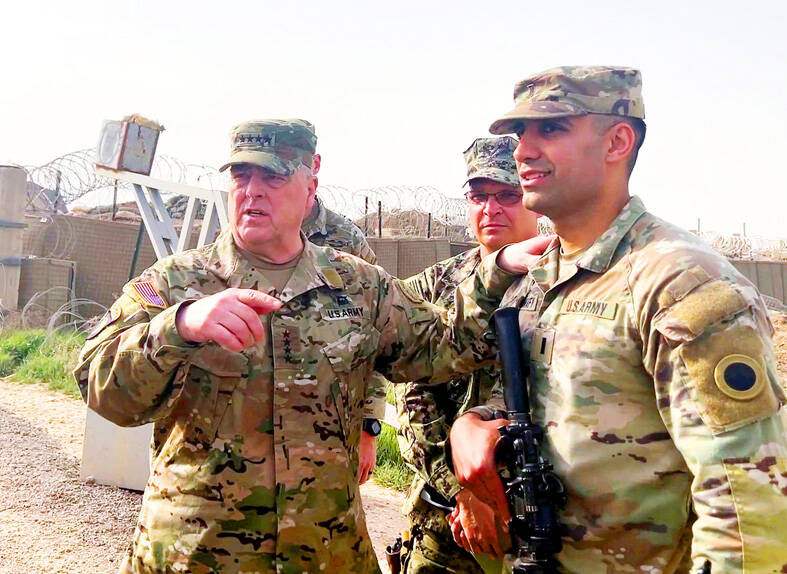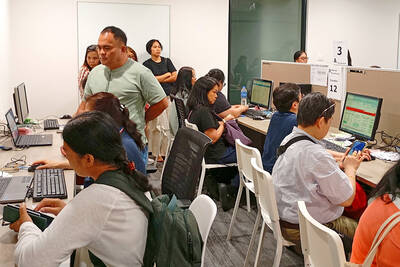The nearly eight-year-old US deployment to Syria to combat the Islamic State (ISIS) is still worth the risk, the top US military officer said on Saturday, after a rare, unannounced visit to a dusty base in the country’s northeast to meet US troops.
US Joint Chiefs of Staff Chairman General Mark Milley flew to Syria to assess efforts to prevent a resurgence of the militant group and review safeguards for US forces against attacks, including from drones flown by Iran-backed militia.
While Islamic State is a shadow of the group that ruled over a third of Syria and Iraq in a caliphate declared in 2014, hundreds of fighters are still camped in desolate areas where neither the US-led coalition nor the Syrian army, with support from Russia and Iranian-backed militias, exert full control.

Photo: Reuters
Thousands of other Islamic State fighters are in detention facilities guarded by Kurdish-led Syrian Democratic Forces, a key US ally in the country.
US officials said that Islamic State could regenerate into a major threat.
However, the mission — which former US president Donald Trump nearly ended in 2018 before softening his withdrawal plans — is remnant of the larger global war against terrorism that had included the war in Afghanistan and a far larger US military deployment to Iraq.
Asked by reporters traveling with him if he believed the Syria deployment of about 900 US troops to Syria was worth the risk, Milley tied the mission to the security of the US and its allies, saying: “If you think that that’s important, then the answer is yes.”
“I happen to think that’s important,” he added.
“An enduring defeat of ISIS and continuing to support our friends and allies in the region ... I think those are important tasks that can be done,” Milley said.
The mission carries some risk. Four US troops were wounded during a helicopter raid last month when an Islamic State leader triggered an explosion.
The US military in Syria last month shot down an Iranian-made drone that was attempting to conduct reconnaissance on a northeastern patrol base.
Three drones targeted a US base in January in Syria’s Al-Tanf region. The US military said two of the drones were shot down, while the remaining drone hit the compound, injuring two members of the Syrian Free Army forces.
US officials said the drone and rocket attacks are being directed by Iran-backed militia, a reminder of the complex geopolitics of Syria, where Syrian President Bashar al-Assad counts on support from Iran and Russia, and sees US troops as occupiers.
Turkey, a US NATO ally, has also threatened a broad offensive in Syria that would threaten the US military’s Syrian Kurdish partners, who are viewed as terrorists by Ankara.
US Combined Joint Task Force Commander Matthew McFarlane, who leads the coalition against Islamic State in Iraq and Syria, described attacks against US forces as a “distraction from our main mission.”
McFarlane cited progress against Islamic State, specifically the reduction in the numbers of internally displaced people at refugee camps — a pool of vulnerable people who could be recruited by Islamic State.
The al-Hol camp houses around more than 50,000 people, including Syrians, Iraqis and other nationals who fled the conflict, and McFarlane estimated that about 600 babies were born there every year.
Michigan National Guard lieutenant Kamal Alsawafy is one of the US soldiers in Syria helping provide security for Iraqis leaving al-Hol in protected convoys for repatriation.
The son of Iraqi refugees who emigrated to the US, Alsawafy said helping Iraqi refugees brings him joy, and described watching people at al-Hol cheering as Iraqis departed the camps for better lives in Iraq.
“It’s a good feeling,” he said.
McFarlane said there would come a time when US partners in Syria could manage on their own, but there is no target date to complete that transition.
“Over time, I do envision us transitioning when the conditions are met, where our partners can independently have a sustainable capacity and capability to keep ISIS in check,” he said.

Kehinde Sanni spends his days smoothing out dents and repainting scratched bumpers in a modest autobody shop in Lagos. He has never left Nigeria, yet he speaks glowingly of Burkina Faso military leader Ibrahim Traore. “Nigeria needs someone like Ibrahim Traore of Burkina Faso. He is doing well for his country,” Sanni said. His admiration is shaped by a steady stream of viral videos, memes and social media posts — many misleading or outright false — portraying Traore as a fearless reformer who defied Western powers and reclaimed his country’s dignity. The Burkinabe strongman swept into power following a coup in September 2022

‘FRAGMENTING’: British politics have for a long time been dominated by the Labor Party and the Tories, but polls suggest that Reform now poses a significant challenge Hard-right upstarts Reform UK snatched a parliamentary seat from British Prime Minister Keir Starmer’s Labor Party yesterday in local elections that dealt a blow to the UK’s two establishment parties. Reform, led by anti-immigrant firebrand Nigel Farage, won the by-election in Runcorn and Helsby in northwest England by just six votes, as it picked up gains in other localities, including one mayoralty. The group’s strong showing continues momentum it built up at last year’s general election and appears to confirm a trend that the UK is entering an era of multi-party politics. “For the movement, for the party it’s a very, very big

A new online voting system aimed at boosting turnout among the Philippines’ millions of overseas workers ahead of Monday’s mid-term elections has been marked by confusion and fears of disenfranchisement. Thousands of overseas Filipino workers have already cast their ballots in the race dominated by a bitter feud between President Ferdinand Marcos Jr and his impeached vice president, Sara Duterte. While official turnout figures are not yet publicly available, data from the Philippine Commission on Elections (COMELEC) showed that at least 134,000 of the 1.22 million registered overseas voters have signed up for the new online system, which opened on April 13. However,

ENTERTAINMENT: Rio officials have a history of organizing massive concerts on Copacabana Beach, with Madonna’s show drawing about 1.6 million fans last year Lady Gaga on Saturday night gave a free concert in front of 2 million fans who poured onto Copacabana Beach in Rio de Janeiro for the biggest show of her career. “Tonight, we’re making history... Thank you for making history with me,” Lady Gaga told a screaming crowd. The Mother Monster, as she is known, started the show at about 10:10pm local time with her 2011 song Bloody Mary. Cries of joy rose from the tightly packed fans who sang and danced shoulder-to-shoulder on the vast stretch of sand. Concert organizers said 2.1 million people attended the show. Lady Gaga